|
SpaceTides e-zine
#55 – July/August 2007
Internet
Newsletter of ASSA Bloemfontein Centre, South
Africa, to the public.
www.assabfn.co.za/spacetides

|
Subscribe to the free SpaceTides e-zine by
sending an e-mail to spacetides@assabfn.co.za
with the word "Subscribe" in the subject line if you are not
already subscribed. |
In this issue of SpaceTides |
INDEX
Double
click on this email in your inbox to open it in a full window
Beware the Mars hoax! (...again)
1. Spaceflight
news from around the world
2. Astronomy: The Lifecycle of Stars
3. Interesting
Space Facts: The milky way as seen from
Earth
4. The
Solar System: Dwarf planet Pluto
5. Sky
Observation log: August 2007 night skies
6. Photo
Sense: Spitzer's infrared look at the Helix nebula
7. SA
Astronomy: Web links and news
___________________________________________________________________________________________
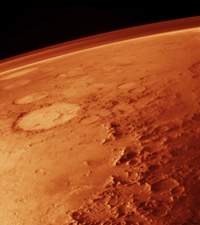
|
Don't be coaxed
into a hoax by the Mars myth... again
Many of you
might have received it again. The (annual) malicious e-mail hoax
claiming that, on 27 August, Mars will come extremely close to the Earth. So
close in fact, that it will look as large as the "full moon"! It
also claims that Mars will easily be visible and only within 56 million km
from the Earth. Quick! Run away! (not from Mars, from the hoax!)
Let's again set the record
straight:
1. For the month of August 2007, Mars will only rise after 1h00 am.
2. On 27 August 2007, Mars will not
be 56 million km away, it will be 175.5 million km away.
3. If Mars is 56 million km from the Earth, it will NOT appear as large as the full moon. In
August 2003 Mars came within 56 million km, the closest in 60,000 years, and
it was nothing more than a bright speck of light in the sky - the average Mr.
Smith and his husky wouldn't even have noticed at all. If Mars came so close to the Earth as to appear
as large as our moon, it will not only disturb the Earth's orbit around the
Sun, but may also wreak havoc with the tides in the oceans. So please ignore that email and resist the
temptation to pass it on to your astronomically-challenged friends!
Go to this Snopes.com article to read the hoax (green box). |
1. Spaceflight news from around the world |
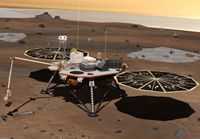
Computer rendering of the Phoenix lander on
Mars. Credit: NASA
|
Mars Phoenix lander approaching launch date
NASA
news release dated 9 July 2007. Read
full release: source.
NASA's next mission to Mars will look beneath a very cold arctic landscape
for conditions favorable to past or present life on the Red Planet. But
instead of roving to hills or craters, NASA's Phoenix Mars Lander will
claw down into the icy soil of the Red Planet's northern plains. The robot will
investigate whether frozen water near the Martian surface might periodically
melt enough to sustain a liveable environment for microbes. To accomplish
that and other key goals, Phoenix will carry a set of advanced research tools
never before used on Mars. Launch is slated for 4-5 August 2007. It will take
the probe over 6 months to travel to Mars.
Phoenix homepage: http://www.nasa.gov/mission_pages/phoenix/main/index.html |
___________________________________________________________________________________________
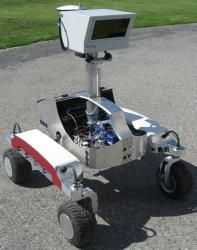
The K10 Red rover. Credit:
NASA
|
NASA robots practicing in the
Arctic for future lunar missions
NASA
news release dated 20 July 2007. Read
full release: source.
Two NASA robots are surveying a rocky, isolated polar desert within a crater
in the Arctic Circle here on Earth. The study will help scientists learn how
robots could evaluate potential outposts on the Moon or Mars.
The robots, K10 Black and K10 Red, carry 3-D laser scanners and
ground-penetrating radar. NASA is planning to send astronauts back to the
moon by 2020. Prior to establishing a lunar outpost, the agency must conduct
detailed surveys at a variety of locations to produce maps, look for minerals
and water, and learn other details.
NASA plans to accomplish its surveys with an automated orbiting spacecraft,
not a robotic lander, but the agency still has a keen interest in advancing
the laser scanning technology.
The 3-D laser scanner can map topographic features as far as a kilometer
away. The ground-penetrating radar, which JPL developed, can map below ground
as deep as 5 meters.
|
___________________________________________________________________________________________
Other
news in Spaceflight
Shuttle Endeavour approaching launch date to ISS
Space
Shuttle Endeavour is ready to fly to the International Space Station, to
mainly deliver a third starboard truss segment. Launch of Endeavour on
mission STS-118 is officially set for Aug. 7. This is the 22nd shuttle flight
to the International Space Station and STS-118 will be the first flight for
Endeavour since 2002. More at NASA.gov.
Mars Rovers caught in huge storms
Rover
engineers are growing increasingly concerned about the temperature of vital
electronics on NASA's Mars Exploration Rover Opportunity while the rover
stays nearly inactive due to a series of dust storms that has lasted for more
than a month. Rover Spirit, meanwhile, is also accumulating some dust on
solar panels under a sky at Gusev Crater that remains nearly as dusty as the
worst Spirit has recorded. From NASA.gov. |
2. Astronomy: The Lifecycle of Stars |
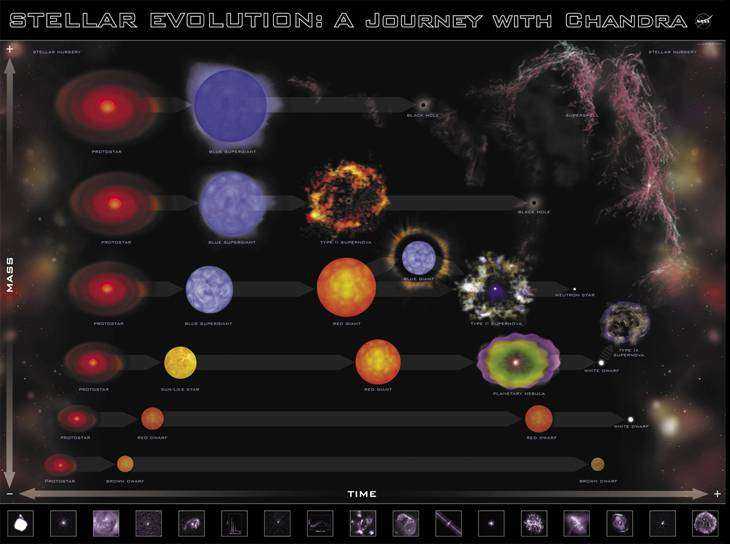
This poster from the Chandra X-ray observatory website is a simplified
portrayel of the stellar evolution of stars with different initial mass: how
massive and heavy a star is after being formed will determine its fate later
in its life. Go to the Chandra website for large, high-res version of poster.
|
Stars
also go through cycles in their lives. From after their initial formation,
they pass through several phases - and eventually "die". Our Sun is an estimated 4.6
billion years old and may live for another 5 billion years (5 000 million)
before its gas supplies run out. When our Sun nears the so-called "red
giant" phase, it will start swelling up as it sheds its outer gas
layers (and scorching the Earth in the process), to eventually form a planetary
nebula. All that will remain of the Sun is a "white dwarf
star", surrounded by the planetary nebula. A white dwarf is a faint,
but very dense star which will eventually die out and form a black dwarf. 110
Earths can fit into the diameter of our Sun at its current size. A white
dwarf however, may be as large as the Earth, but a teaspoonful of its matter
can weigh several tons! White dwarfs usually consist of carbon and oxygen, or
in some cases helium.
The
"birth place" of stars are nebulous
clouds of hydrogen gas in space. What will happen to a
star during its lifecycle will depend on its initial mass shortly after it
formed, and for this purpose we can discern between the following categories
of stars:
1) those that have a high mass (8 times or more than
our Sun's mass),
2)
intermediate-mass stars, with 0.5 to 8 solar masses - the group that
includes our Sun; and
3) low-mass stars, with 0.1 to 0.5
solar mass. Objects with less than 0.1 solar mass do not have enough
gravitational force to produce the core temperature necessary for hydrogen
fusion and won't become a star. They typically remain a "brown
dwarf".
Massive
stars burn their hydrogen fuel much
quicker than do stars with less mass. They don't live very
long either: sometimes only a few hundred million years, or if they are
really massive, only a few millions! These high-mass stars can blow up in
spectacular supernova explosions,
forming immense gas clouds (nebulae) in space. They don't leave white dwarf
stars behind, but form much more exotic objects such as neutron stars, or
even black holes if they are massive enough...
Based on information obtained from NASA
Worldbook: http://www.nasa.gov/worldbook/star_worldbook.html
|
3. Interesting Space Facts |
The milky way as seen from Earth
- The path of stars that you see on dark nights in the sky is
commonly called the milky way (lower case letters). Our spiral galaxy's name
is also called the Milky Way (in capital letters!)
- The milky way represents arms of our spiral Milky Way galaxy and appears so
bright because of the numerous stars within it. When you look into the milky
way in winter you look into the Sagittarius arm and in summer you look
towards the Perseus arm. Our Sun is situated in the Orion arm.
- The galactic centre of the Milky Way Galaxy (capital letters!) lies in the
direction of the constellation Sagittarius.
- The dark patches that you see in the milky way consist of cosmic dust and
gas, which obscures the light from the stars in the background. One such
example of dust and gas is the “Coal Sack nebula” visible below the Southern
Cross.
For an in-depth explanation of our Galaxy's spiral structure and names of its
spiral arms, visit Wikipedia.org. |
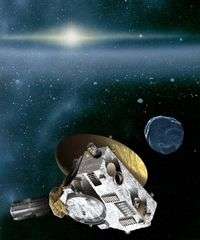
Artist rendering of the New Horizons probe on
its way to the Kuiperbelt.
Credit: JHUAPL/SwRI
|
Dwarf planet Pluto
Pluto (named after
the Greek god of the Underworld), was discovered in 1930 by Clyde Tombaugh.
It is almost 6 billion km (6 000 million) from the Sun. Pluto was designated
a dwarf planet in August 2006, after a resolution by the International
Astronomical Union that a solar system body must adhere to the definition of
a planet. Pluto did not meet the criteria, but did met those of a "dwarf
planet".
Pluto's diameter is about 2 300 km, making it smaller than our Moon (our Moon
is about 3 400 km in diameter). Pluto is sometimes refered to as a double
planet because of its largest moon Charon being half the diameter of Pluto.
It has 3 discovered moons: Charon, Hydra and Nix.
Pluto is in fact one of the largest members of a group of icy objects located
in an area just beyond Neptune called the "Kuiper Belt". The Kuiper Belt is made up
of possibly millions of icy and rocky objects such as asteroids. Scientists
believe that some comets come from the Kuiper Belt and the still hypothetical
Oort Cloud beyond.
More information on Pluto at Wikipedia: http://en.wikipedia.org/wiki/Pluto
Website for the New Horizon's probe en route to Pluto: http://pluto.jhuapl.edu/
This is the 10th part in a 12-part series about
the Solar System. |
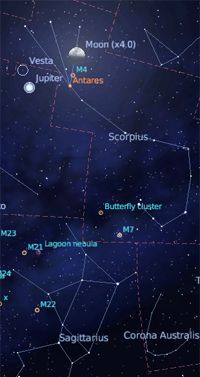
The area around Scorpius and Sagittarius on 21 August 2007.
Credit: Stellarium.
|
Planets - August 2007
Mercury is
visible in the east before the sun rises until about the 8th of August. It
reappears in the evening skies later in the month. Venus is shining
very bright in the evening skies until mid-month. Mars is visible from
after 1h00 in the mornings in Taurus. Jupiter shines almost directly
overhead in the evenings, close to the Scorpion. Saturn is saying
farewell and can only be seen during the first week after sunset in the west. Uranus is in Aquarius while Neptune is in Capricornus. Dwarf
planet Ceres can be found in Taurus, while Pluto is in
Sagittarius. Asteroid Vesta is located in Ophiuchus close to Jupiter.
Stars
& Constellations - August 2007
Above the northern horizon you will find constellations such as Corona
Borealis (the Northern Crown), Hercules the Hero and Lyra the
Harp. Rising shortly after Lyra is the early spring constellation of Cygnus the Swan. Above your head you will find the Scorpion, followed by Sagittarius the Archer. The large constellation of Ophiuchus, with its two Serpents,
can be found below Scorpius slightly to the north. Aquila the Eagle is
visible in all its glory in the north-eastern skies, flying gracefully into
the milky way.
Deep
Sky Objects for binoculars and telescopes - August 2007
Binoculars: M8 (Lagoon nebula), M20 (Trifid nebula) and M22 (a bright,
large globular cluster) all in Sagittarius. NGC 6633 (open cluster) in
Ophiuchus.
Telescopes: M11 (Wild Duck open cluster) in Scutum, M17 (Swan nebula)
in Sagittarius,
NGC 6397 (a globular cluster) in Ara.
Other
night sky phenomena
New Moon on 13 August 2007
Full
Moon on
28 August 2007
August 1 to 10: Venus, Saturn and the star Regulus closely
group after sunset in west.
August
21: Close pairing of asteroid Vesta, planet Jupiter and natural
satellite Moon.
Sources: detailed sky phenomena can be found in the 2007 Sky Guide
handbook. Where are all these objects situated? Contact us for a free sky map, or
download Stellarium. |
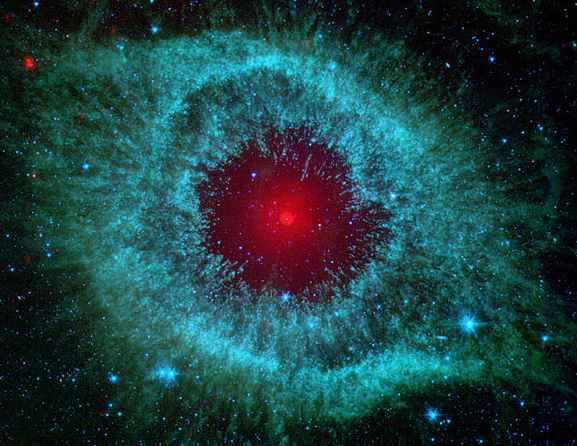
"This
infrared image from NASA's Spitzer Space Telescope shows the Helix
nebula, a cosmic starlet often photographed by amateur astronomers for
its vivid colours and eerie resemblance to a giant eye. "
"The nebula, located about 700 light-years away in the constellation
Aquarius, belongs to a class of objects called planetary nebulae. Discovered
in the 18th century, these colourful beauties were named for their
resemblance to gas-giant planets like Jupiter. Planetary nebulae are
the remains of stars that once looked a lot like our sun. When sun-like stars
die, they puff out their outer gaseous layers. These layers are heated by the
hot core of the dead star, called a white dwarf, and shine with infrared and
visible colours. Our own sun will blossom into a planetary nebula when it
dies in about five billion years".
Credit:
NASA/JPL-Caltech/K. Su (Univ. of Ariz.). Click
to go to source (Spitzer: Caltech)
|
7. Astronomy in Southern Africa |
Boyden Observatory open evening on 25 August 2007:
The
next Boyden open evening in Bloemfontein will be on 25 August 2007
(Saturday). Please see the press, including local newspapers, for information
about times and other details.
ASSA national website updated:
Go to
the website of the national Astronomical
Society of Southern Africa for the latest news in SA Astronomy and other
related info.
What's up in the August night skies on the SAAO website:
http://www.saao.ac.za/public-info/sun-moon-stars/august/
KAT -
XDM saw First Light in July 2007
"The eXperimental Development Model (XDM) is a 15-m diameter radio
telescope antenna of novel design intended to reduce antenna construction
cost per square metre and bring it close to that needed to make Square
Kilometre Array (SKA) affordable. IST Holdings are the prime contractors
building XDM at Hartebeesthoek." From HartRAO: http://www.hartrao.ac.za/news/070716XDM_first_light/index.html |
_____________________________________________________________________________________________________________________
SpaceTides is a free
internet e-zine for persons interested in expanding their general knowledge of
astronomy and spaceflight.
The e-zine originates from the City of Bloemfontein in South Africa and is
compiled us a service to the public by ASSA Bloemfontein Centre
as part of their educational outreach activities. Website: www.assabfn.co.za.
SpaceTides contains links to various other third party sites on the
internet, not always connected to SpaceTides. The persons and entities
responsible
for compiling SpaceTides cannot be held responsible for the content or
information on these third party sites or any damage of any kind incurred
from
downloading, opening, or viewing anything from/through these sites.
Subscribe to SpaceTides by sending an e-mail to spacetides@assabfn.co.za with the word
"Subscribe" in the subject line.
If
you would like to Unsubscribe from SpaceTides, send an e-mail to spacetides@assabfn.co.za with the word
"Unsubscribe" in the subject line.
_____________________________________________________________________________________________________________________________
|



